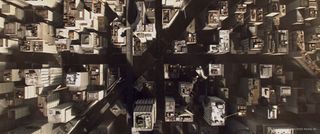How to create a stunning film with no budget
OFFF 2015: 18 things you can learn from Postpanic's auction of viral short 'Sundays' to Warner Bros.
Last year, director Mischa Rozema and Amsterdam-based hybrid studio PostPanic released a mind-bending teaser for their sci-fi film, Sundays, at OFFF Barcelona.
The stunning 14-minute short, which evokes films like Inception, is the latest in a growing trend for emerging film-makers to wow global entertainment companies with proof of concept and a slick showcase of their skills.
It was shot in Mexico with money raised from a successful KickStarter campaign and released to the world in March 2015.
This year, the team are back in Barcelona – with Warner Bros on-side. The media conglomerate won an auction for the right to create a feature film out of Sundays, just four days after the short went viral.
Last night PostPanic premiered Sundays in Spain at OFFF 2015. We caught up with Rozema and the PostPanic team afterwards to find out how a first-time feature director persuaded one of the world's biggest studios to support his film - and how anyone with a good idea but no budget can their project off the ground…
- You'll find a tutorial from PostPanic on how to extend a film set with V-Ray in the June issue of 3D World, 195: buy your copy here!
01. Get serious on social media

"We've developed our name as PostPanic over 17 years through an online community of creatives worldwide, who have supported us, so we knew there were people who would be interested in seeing a film coming out under the PostPanic brand," says producer Ania Markham.
"That was a good position to launch a Kickstarter campaign. Then, it was all about very intense social media and keeping people informed."
02. Share the vision
"We shared the vision throughout the Kickstarter campaign," continues Markham. "We'd have been happy just with 10 dollars but we were humbled by the whole experience - some people went as far as five thousand. I mean, that's unbelievable... The belief and that absolute kind of generosity to make this vision happen was staggering."
03. Respect your investors

"Something that we didn't expect was our feeling of responsibility towards the community that was facilitating our dream coming true – to be able to film in Mexico City," adds Markham, "You know, if they're going to give us the money then we need to create something that's worth the trust they've given us, so we had to put the bar really high."
04. Accept help when it's offered
"The other thing that was unexpected was how many volunteers came out of that community. It was made out of creative professionals around the world, many of which were visual effects specialists – and their expertise was offered voluntarily."
"We had this huge community of volunteers. For us, the whole Kickstarter experience was very, very positive - but it was hard work, it really was," says Markham.
05. Tempt Hollywood with proof of concept

"One of the first edits we made was already 40 minutes long," recalls director Mischa Rozema, explaining that the team initially made a complete short that rounded up the whole story.
"That completely defeats the purpose of making a concept short for a feature film, because the goal was to create attention and raise questions for people who have watched the concept short, making them want more, to be able to actually see a feature film made out of this."
06. Know your audience's attention span
"We figured out that 14 minutes would be the maximum attention span for the internet these days," Rozema continues. "I mean if I look at myself, I don't even watch short films on the internet that much because they take a lot of time. Time is pretty valuable when you're on the internet, so 14 minutes was the maximum."
07. Create a "two-step rocket"

The idea behind Sundays was not to give away much about the story. "It was to create the world, and the look and feel of what you're buying into if you want to see the feature," says Rozema. "I always call it a two-step rocket: one is the proof of concept, which shows the look, feel and texture of the film; and the second is the actual feature script."
"The feature script was finished in November 2014 and then we had the proof of concept. So together these two things would sell the idea to studios and production companies."
"That was the plan, but it kind of blew up in our faces – in a very good way – because the concept short itself created so much interest. We were able to sell this whole thing without the actual story attached. But the story is there and it did what it was meant to do."
08. Learn to maintain a volunteer workflow
"We have our own in-house team at PostPanic, but we needed extra people," explains Markham. "We had an amazing army of volunteers: some of the best visual effects artists out there who all donated their time for the love of it - we weren't paying them."
"That was amazing, but when you've got volunteers you can't put pressure on them from a deadline point of view. So one of the biggest challenges was how to maintain a workflow that accommodated volunteers with day jobs and commitments on commercial projects. We had to offer a degree of flexibility, while keeping the pressure on internally to make all these shots."
Get 10 issues of Computer Arts free!
To celebrate OFFF Barcelona 2015, Computer Arts is offering all overseas readers the opportunity to get up to a huge 10 free issues of the world's best-selling magazine for designers, with a two-year subscription. Offer ends 15 June.
Next page: 10 more tips for launching a new film project

Thank you for reading 5 articles this month* Join now for unlimited access
Enjoy your first month for just £1 / $1 / €1
*Read 5 free articles per month without a subscription

Join now for unlimited access
Try first month for just £1 / $1 / €1
Get the Creative Bloq Newsletter
Daily design news, reviews, how-tos and more, as picked by the editors.
The Creative Bloq team is made up of a group of design fans, and has changed and evolved since Creative Bloq began back in 2012. The current website team consists of eight full-time members of staff: Editor Georgia Coggan, Deputy Editor Rosie Hilder, Ecommerce Editor Beren Neale, Senior News Editor Daniel Piper, Editor, Digital Art and 3D Ian Dean, Tech Reviews Editor Erlingur Einarsson and Ecommerce Writer Beth Nicholls and Staff Writer Natalie Fear, as well as a roster of freelancers from around the world. The 3D World and ImagineFX magazine teams also pitch in, ensuring that content from 3D World and ImagineFX is represented on Creative Bloq.




